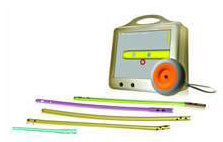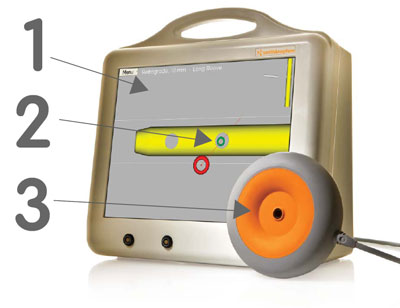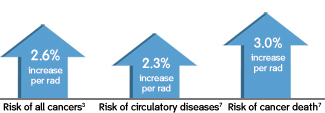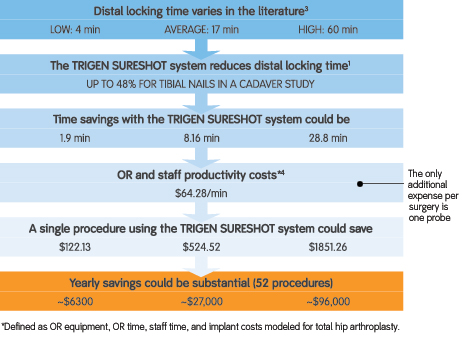


The revolutionary TRIGEN SURESHOT system is a safe, convenient, and cost effective technology for fracture repair in the OR.

Download the TRIGEN SURESHOT Product Brochure
“Any radiation dose carries with it an associated risk of cancer induction, and the risk increases linearly with increasing dose." 5
--- Klein et al, 2009
The relationship between exposure to ionising radiation and cell damage, which may result in cancer, is well documented in the literature1-3
A significant dose response causes increased risks For each rad of radiation exposure a surgeon receives in a lifetime, risks increase.

The National Council on Radiation Protection & Measurements (NCRP) recommends using as low as reasonably achievable (ALARA) levels of radiation8
The TRIGEN SURESHOT system helps increase efficiency and reduce variability with shorter procedures 1

Click Here to learn how TRIGEN SURESHOT can reduce costs
Get your radiation exposure under control.
1. Cardis E, Vrijheid M, Blettner M, et al. The 15-country collaborative study of cancer risk among radiation workers in the nuclear industry: estimates of radiation related cancer risks. Radiat Res. 2007;167(4):396-416.
2. Muirhead CR, O'Hagan JA, Haylock RG, et al. Mortality and cancer incidence following occupational radiation exposure: third analysis of the National Registry for Radiation Workers. Br J Cancer. 2009;100(1):206-212.
3. Sont WN, Zielinski JM, Ashmore JP, et al. First analysis of cancer incidence and occupational radiation exposure based on the National Dose Registry of Canada. Am J Epidemiol. 2001;15 (4):309-318.
4. Report of the United Nations Scientific Committee on the Effects of Atomic Radiation to the General Assembly. 2000. >http://www.unscear.org/docs/reports/gareport.pdf. Accessed February 17, 2010.
5. Klein LW, Miller DL, Balter S, et al. Occupational health hazards in the interventional laboratory: time for a safer environment. Catheter Cardiovasc Interv. 2009;73(3):432-438.
6. Center for Devices and Radiological Health, US Food and Drug Administration. Initiative to reduce unnecessary radiation exposure from medical imaging. http://www.fda.gov/Radiation-EmittingProducts/RadiationSafety/RadiationDoseReduction/ucm199994.htm . Updated February 16, 2010. Accessed February 22, 2010.
7. Ashmore JP, Krewski D, Zielinski JM, Jiang H, Semenciw R, Band PR. First analysis of mortality and occupational radiation exposure based on the National Dose Registry of Canada. Am J Epidemiol. 1998;148(6):564-574.
8. National Council on Radiation Protection & Measurements. The application of ALARA for occupational exposures. NCRP Statement No. Issued June 8, 1999.http://www.ncrponline.org/Publications/Statement_8.pdf. Accessed February 22, 2010.
1. Tornetta P, Patel P, Tseng S, Whitten A, Ricci W. Distal locking using an electromagnetic field guided computer based real time system. Poster presented at: Annual Meeting of the Orthopaedic Trauma Association; October 8-10, 2009; San Diego, CA.
2. Peersman G, Laskin R, Davis J, Peterson MG, Richart T. Prolonged operative time correlates with increased infection rate after total knee arthroplasty. HSS J. 2006;2(1):70-72.
3. Data on file. Smith & Nephew.
1. Center for Devices and Radiological Health, US Food and Drug Administration. Initiative to reduce unnecessary radiation exposure from medical imaging. http://www.fda.gov/Radiation-EmittingProducts/RadiationSafety/RadiationDoseReduction/ucm199994.htm. Published February 2010. Accessed February 11, 2010.
2. Whatling GM, Nokes LD. Literature review of current techniques for the insertion of distal screws into intramedullary locking nails. Injury. 2006;3 (2):109-119.
3. Data on file. Smith & Nephew.
4. Tornetta P, Patel P, Tseng S, Whitten A, Ricci W. Distal locking using an electromagnetic field guided computer based real time system. Poster presented at: Annual Meeting of the Orthopaedic Trauma Association; October 8-10, 2009; San Diego, CA.
 Moore, Chris, MS; Heeckt, Peter, MD.
Moore, Chris, MS; Heeckt, Peter, MD.
Reducing Radiation Risk in Orthopaedic Trauma Surgery, Bone&Joint Science. Vol 02, No 07 - July 2011
Radiation risk to the orthopaedic trauma surgeon and OR staff originates from two sources. There are four primary protective measures which can limit primary and scatter radiation exposure.
Download Reducing Radiation Risk in Orthopaedic Trauma Surgery Research Paper
 White Paper prepared by the FDA and Center for Devices and Radiological Health
White Paper prepared by the FDA and Center for Devices and Radiological Health
Through the initiative to Reduce Unnecessary Radiation Exposure from Medical Imaging, FDA and our partners will work to measurably reduce unnecessary exposure to patients to radiation in CT, fluoroscopy, and nuclear medicine imaging exams.
 Tornetta III, Paul; Whitten, Andy; Patel, Priyesh; Tseng, Susan; Ricci, William
Tornetta III, Paul; Whitten, Andy; Patel, Priyesh; Tseng, Susan; Ricci, William
A new technology, using an electromagnetic field generator, a wand that goes down the nail, and computer based calibrated software has been created to allow distant locking without fluoroscopy.
Download The Magic Wand For Distal Targeting White Paper
Watch the TRIGEN SURESHOT screw insertion video on YouTube
Screw targeting during intramedullary nailing of long bone fractures can be a laborious process and is highly dependent upon radiographers, often becoming the most frustrating and time-consuming step of the procedure. The vast majority of surgeons use a fluoroscopic method reliant upon obtaining ‘perfect circles'. This technique requires assistance to hold the extremity in a specific position and expertise from the radiology technician. Additionally, this technique is characterized by a moderate learning curve with variable accuracy, the potential for screw malalignment and exposes the patient and surgical staff to radiation.
The TRIGEN SURESHOT Distal Targeting System utilizes an electromagnetic field generator, a probe inserted into the nail, and virtual imaging to facilitate distal locking without fluoroscopy. This revolutionary system is radiation free, position independent, and provides 3D real time feedback of location and orientation of the drill relative to the nail interlocking hole to provide unsurpassed accuracy. The TRIGEN SURESHOT Distal Targeting System was designed to mimic the ‘perfect circle' technique and has virtually no learning curve.
In combination with the superior TRIGEN IM Nail System, the TRIGEN SURESHOT Distal Targeting System allows surgeons to exercise maximum control in the operating theatre, benefitting everyone including the patient and theatre staff. TRIGEN SURESHOT delivers optimal outcomes by providing the surgeon maximum command during intramedullary nailing and by reducing radiation exposure, anesthesia time and time in the OR, all while increasing accuracy.
The TRIGEN SURESHOT Distal Targeting System is the revolutionary approach to distal locking and further establishes the TRIGEN IM Nail System as the driving force in advancing and improving the efficacy of intramedullary nailing.
The Smith & Nephew TRIGEN SURESHOT Distal Targeting System is intended to be an intraoperative image-guided localisation system. It is a computer-assisted orthopaedic surgery tool to aid the surgeon with drill positioning for screws during intramedullary nail implantation. It provides information to the surgeon that is used to place surgical instruments during surgery utilising intraoperatively obtained electromagnetic tracking data. The Smith & Nephew TRIGEN SURESHOT Targeting System V2.1 is indicated for long bone fractures treated with intramedullary nails in which the use of stereotactic surgery may be appropriate. An example of a surgical procedure includes but is not limited to locating and drilling the distal holes in an intramedullary nail.
The screw targeting software application for this system is contraindicated for all IM nails other than Smith & Nephew TRIGEN META-NAIL, TAN, FAN, Humeral, Pediatric and Adolescent nails. Do not operate the TRIGEN SURESHOT Targeter within 200mm of an installed pacemaker. The magnetic field produced by the Targeter may interfere with the operation of the pacemaker.
The TRIGEN SURESHOT Distal Targeting System is only designed for use with the indicated implants and instruments. Implants and instruments must be used in accordance with the instructions, as described in this manual and/or in the non-navigated surgical procedure.
Only trained operators are allowed to use the TRIGEN SURESHOT Distal Targeting System. The various operating instructions must be fully read and understood as part of the training. If any part of the instructions is not clear, please contact your local representative.